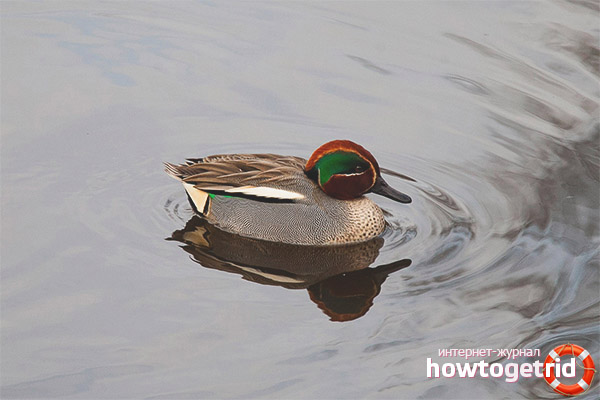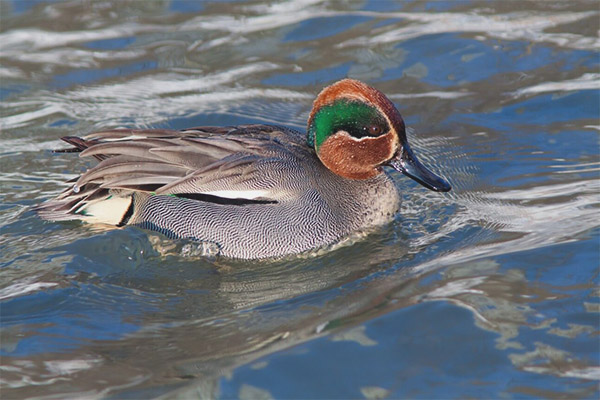The content of the article
This little duck is three times less than ordinary mallard, reaches a length of no more than 38 centimeters, and in weight - no more than 450 grams. Females are distinguished by their special miniature, their weight fluctuates around 250 grams. For this reason, this representative of the duck family is the smallest of the ducks that live in rivers and lakes. Its thin and sonorous whistling can always be distinguished among the voices of other birds. Because of this teal and nicknamed "whistle".
Habitat
Almost all teals live in temperate and northern climates, preferring Eurasia. A separate subspecies of teals are green-winged teals. They nest in North America. The duck is a migratory bird and goes to the western or southern part of Europe, Africa or Asia for wintering. The nest forms in pairs, lives in a flock.
She prefers forest ponds.There the bird feels comfortable, reaching the largest number of the flock. Teal nests can be found in the forest tundra and forest-steppe. However, in the steppe the whistle-hole survives extremely rarely, but often in the tundra. From there, teal flies for wintering already in September, and from the central belt - at the end of October.
In the mating season, birds give particular preference to small ponds with fresh water and swamp vegetation: small lakes, streams, river floodplains, small rivers.
When the period of egg laying in a bird is over, it can be found on the water meadow, the reservoir, and sometimes even on the sea coast or in the river delta. For her, the main thing is that more plants stick out of the water, especially during a difficult period of molting, since lost wing feathers. So it is easier for her to hide from predators and find food for herself.
Features and reproduction
In the world there are as many as twenty types of teals. All of these waterfowl birds belong to river birds. The whistlers were lucky - while their populations are not particularly threatened by anything, the marble teal is already under threat of extinction. Ornithologists claim that the last time data on its population were recorded in 1984. Teal-gogol, for example, today reminds of itself only from a catch phrase.These birds have disappeared without a trace.
In addition to these types of teals distinguish:
- blue;
- gray;
- Madagascar;
- Oakland;
- brown;
- brown;
- Campbell's;
- chestnut.
In addition to the official name "whistle", miniature teal is also called small or crackler. Sometimes you can even hear the name "sexual."
Take off teal - a truly spectacular sight. Whistling almost immediately takes a vertical position in the air. This unique feature is peculiar only to these birds because of the special structure of the wing. It has a narrow and pointed shape. Thanks to such wings, teal easily lands on almost any surface, which helps him very much in flying over swamps and rivers.
Very often the birds can be found in the company of mallards. It is no coincidence, because the birds have the same nesting sites. Outwardly, they are difficult to confuse with each other, as the teals have certain greenish areas of feathering on the wings that are so smooth that they even shine.
In the rest of the summer the bird is painted rather inconspicuously. Most of its plumage has a dark brown color, except for the abdomen - here it has a white feather.In spring, all males are transformed, becoming bright and attractive to females. After molting, the plumage of their heads acquires a red-brown color with green stripes on the sides. Fine white lines run along the edge of the green stripes, descending from two sides to the very beak. The rest of the body of the drake has a gray tint with light brown patches in the form of small specks.
Feeding birds is not a great variety. They're eating:
- crustaceans;
- insects and their larvae;
- various midges;
- worms;
- tadpoles;
- mollusks;
- duckweed and cereal seeds.
Protein food birds get themselves both from the air and from the water. While hunting for shellfish or other aquatic inhabitants, they literally “stand” in the water on their heads. On the surface remains only the tail and legs. So, like a float, they get their own food. When it becomes colder and the living creatures become smaller, the birds search for plant food on the shore, in the reeds and coastal grass, picking up various grass seeds with their beaks, and especially preferring the soft duckweed.
At the age of one year, miniature ducks are ready for mating games. Couples are formed until the birds arrive at the nesting site.Birds perform mating dance exclusively on the water. The male swims around his girlfriend, pressing the colorfully painted head to his chest and lowering his beak into the water. From time to time he throws his head up and raises the spread wings. At the same time everything around is filled with sparkling splashes and a ringing whistle. A duck at this time throws back his head and as if pecking at someone, turning his neck to the right, then to the left. After dancing, it is time to lay eggs. Their female lays from 5 to 15-16 pieces. This number of eggs contributes to the preservation of the teal population.
These birds build nests unpretentious: from grass, reed and small twigs. Like any other bird, a duck carpets it with its down in order to maintain a constant temperature of the clutch. Small eggs have a beige tint, which makes them almost invisible among the grass.
In teals, females are engaged in building the nest and incubating chicks, while the males go for molting. Ducklings appear from eggs for 22-30 days. The warmer the air temperature, the shorter the chick-breeding period.
Ducklings are born in motley fluff and from the first days independently move behind the mother.Very quickly, they learn to swim and self-hunt under the supervision of a duck.
In the wild, strong whistling individuals live to be 16 years old, and in captivity - to 30 years.
Interesting Facts

Ornithologists call codfish the most carefree representative of ducks. It is no coincidence. Birds show dexterity on the water, but on land they behave sluggishly and even slowly. In the case of flight from a predator, they are often very poorly disguised and hide, becoming its prey.
Though the females take the “upbringing” of the offspring to themselves, the males, moving away from them to molt, keep close to the nest. For the wintering, teal whistles fly away before the other ducks - already in the middle of August.
Whistles are not threatened with extinction in the near future, but the growth rate of the population as a whole has slowed down and there is even a tendency to reduce them.This is due to the global deterioration of wildlife and climate change on the planet. It interferes with the population and agricultural activities of man, as a result of which bird nests are often ruined.
Today, in order to preserve this species, it is artificially grown in zoological nurseries and gardens. The bird feels good in captivity and breeds successfully.
Video: teal - whistle and crackle











To send